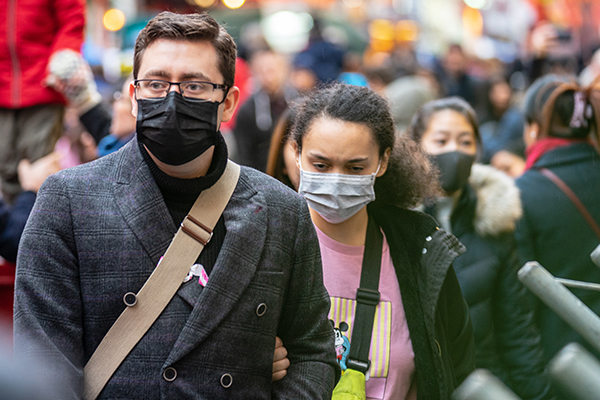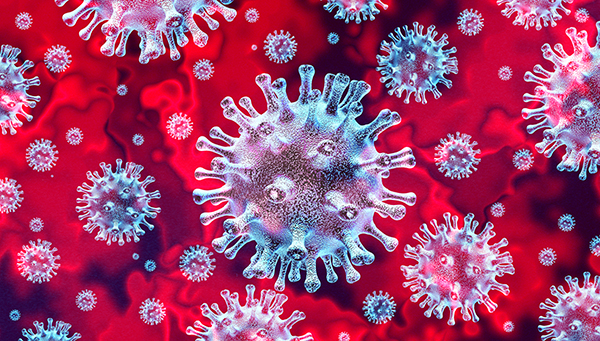Written by Steven Burns
From his column To Your Health
 It’s another busy day in the office, and I walk into an exam room. Jacob, a long-time patient, is sitting on the exam table—coughing. He looks sick, but not terribly sick.
It’s another busy day in the office, and I walk into an exam room. Jacob, a long-time patient, is sitting on the exam table—coughing. He looks sick, but not terribly sick.
“Doc, I’ve been coughing for the last three days. No real fever, and I’m not coughing anything up, but I’m a little bit worried.”
I look over his chart—normal temperature, blood pressure, and pulse. His weight is too high, but unchanged from his last visit. “Well, let’s figure this out. Are you having night sweats, body aches, shortness of breath?”
He shakes his head to all three. “No, just the cough. I heard about that new bug from China, that coronavirus. Have you seen any cases of that one?”
I reassure him that, even though there has been a case in our area (at Arizona State University), there is almost no chance his cough is due to coronavirus. We talk about symptom relief (cough medications and ibuprofen), the lack of benefit of antibiotics (“It can add diarrhea to your problems, otherwise antibiotics won’t help much”), and when to call me if he gets worse. He leaves the office seemingly happier and healthier than when he came in.
So, what about all those weird viruses? When should you get worried?
Most coronaviruses cause mild upper respiratory infections, or “colds.” The problem with COVID-19 is that it appears much more contagious than MERS, and has already become more widespread worldwide than SARS. As of publication (early March), the virus has killed more than 3,100 people and has infected more than 90,000.
The most recent viral scare, a coronavirus from Wuhan, China, is an excellent case in point. Over the past 20 years there have been two similar scares.

that has the attention of the world right now,
is part of a family known as coronaviruses.
The name itself is an abbreviation for
Coronavirus Disease – 2019. Coronaviruses
generally begin in animals and are passed
to humans through personal contact. The
virus is transmitted between humans via
close contact—largely by breathing droplets
produced when an infected person coughs
or sneezes. Coronaviruses are responsible
for such illnesses as the common cold, but
may manifest themselves in severe
variations such as SARS (Severe Acute
Respiratory Syndrome) MERS (Middle East
Respiratory Syndrome), and COVID-19.
Symptoms often include mild to moderate
upper respiratory problems, fever, cough,
and difficulty breathing. Severe infections
may lead to pneumonia, kidney failure, and
death.
The name coronavirus is derived from the
Latin word “corona” which means “garland”
or “crown.” Under a microscope, corona-
viruses have crown-like spikes on their
surface. (Source: World Health Organization
and Centers for Disease Control)
The virus is spread by droplets formed when an infected person sneezes or coughs. This virus may be as contagious as the flu, meaning it is extremely contagious. It appears that it can survive on surfaces, meaning that being in the vicinity of an infected person is likely to expose a non-infected person. The ways to avoid contracting the illness include using masks and very careful hand washing.
Hospitals and clinics have prepared for the virus by changing the triage protocols for patients who have a cough or fever. My local hospital emergency department has started immediately placing masks on patients who have these symptoms, and moving them to a separate waiting areas. During the SARS epidemic, in 2002-2003, epidemiologists in Canada showed that such measures greatly reduced the numbers of people who contracted the illness in hospitals. One province used careful and methodical precautions while another did not, and the rates of infection in the careless province far exceeded those in the other.
So, what should you do? First, get your flu shot. Flu has killed between 12,000 and 61,000 annually, since 2010. Second, if you or others have a fever and cough, stay home! If you have to go out while sick, wear a mask. Masks for prevention of contagion are available at your local drugstore. Third, if you have a cough, fever, and shortness of breath, call your doctor. There is a test available for those who meet strict criteria. At present, the test is in very short supply, but if you are one of those with COVID-19, it is in everyone's best interest to find that out.
Actions that Do Not make sense are avoiding or otherwise discriminating against individuals with an Asian heritage. That is just as awful as assuming any other race carries diseases. Such beliefs have been used for centuries to justify discrimination against immigrants and those who are different in some way. Those assumptions are always burdensome, incorrect, and simply unchristian.
Keep tuned to the news on this rapidly-changing topic. It is important that we not be fearful, but that we stay informed. Remember: “Are not two sparrows sold for a penny? Yet not one of them will fall to the ground outside your Father’s care. And even the very hairs of your head are all numbered. So don’t be afraid; you are worth more than many sparrows” (Mt 10:29-31 NIV).
For more information, visit the World Health Organization or the Centers for Disease Control. Also, Christianity Today has this helpful guide for churches on how to deal with the coronavirus.
Dr. Steven Burns is board-certified in family medicine and has been in practice for more than 30 years.
